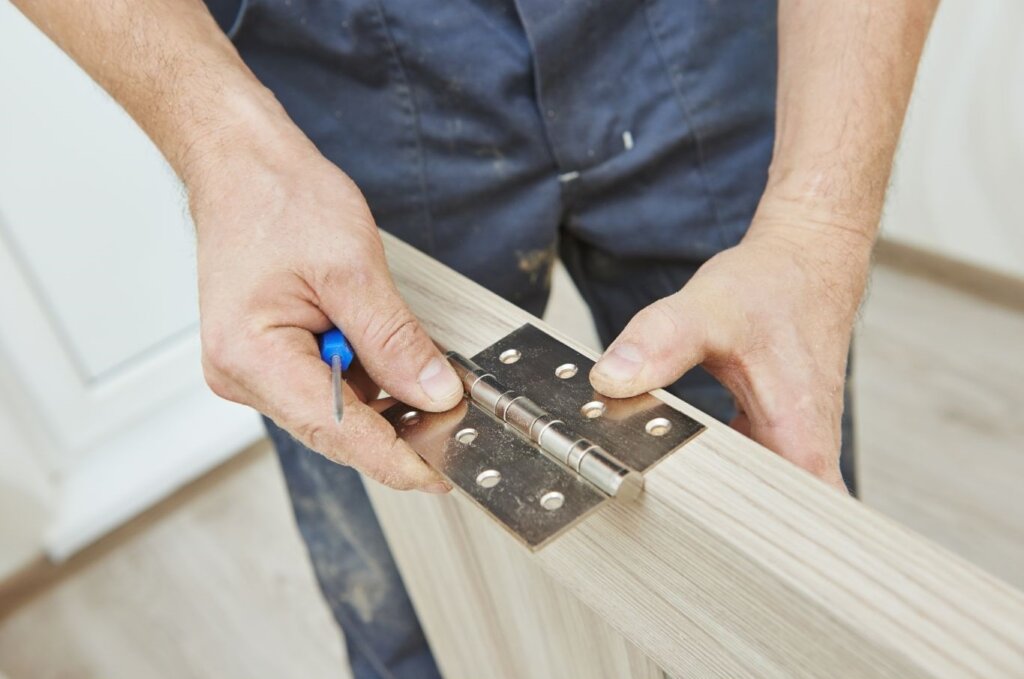As a homeowner, it’s important to have a clear understanding of the various components that make up your home. One area that often raises questions is the difference between installing doors and frames. While these two elements work together to create an entryway, they have distinct roles and characteristics. In this article, I will delve into the basics of installing doors and frames, discuss the types of doors suitable for your home, explore the factors to consider when choosing a frame, and provide guidance on the installation process. By the end, you’ll have a comprehensive understanding of this often-misunderstood topic.
The basics: What is the difference between installing doors and frames?
Before we dive into the details, let’s start with the basics. The door is the movable barrier that allows entry or exit to a room or building, while the frame is the structure that surrounds and supports the door. Doors come in various styles, materials, and sizes, serving different purposes within a home. On the other hand, frames are typically made of wood, metal, or composite materials and provide stability and security to the door. Understanding the distinction between the two is crucial for a successful installation process.
Types of doors you should install at home
Now that we have a solid grasp on the difference between doors and frames, let’s explore the different types of doors that are suitable for your home. One popular choice is the traditional hinged door, which swings open and closed on hinges attached to the frame. These doors are versatile and can be used for both interior and exterior purposes. Sliding doors, on the other hand, are an excellent option when space is limited, as they glide along a track instead of swinging open. They are commonly used for patio or closet entrances. Other types of doors include bi-fold doors, pocket doors, and French doors, each with their own unique features and benefits.
Where to install your door and how to choose the right location
When it comes to installing a door, choosing the right location is crucial for both functionality and aesthetics. Exterior doors are typically installed at the front and back entrances of a home, providing security and insulation. Interior doors, on the other hand, are used to separate rooms, control noise levels, and ensure privacy. It’s important to consider factors such as traffic flow, natural light, and the overall layout of your home when deciding where to install your door. Additionally, be mindful of any structural elements, such as load-bearing walls, that may affect the installation process.
To choose the right location, start by assessing the purpose of the door and the needs of the rooms it will connect. For example, if you’re installing a door between your living room and kitchen, consider the convenience of accessing the kitchen while entertaining guests. Additionally, take into account the direction of the door swing, ensuring it won’t obstruct any fixtures or furniture. By carefully considering these factors, you can make an informed decision about the best location for your door.
How to install your door: Step-by-step guide
Now that we’ve covered the basics and determined the type and location of your door, it’s time to dive into the installation process. While it may seem daunting, installing a door is a manageable task with the right tools and guidance. Here is a step-by-step guide to help you through the process:
- Measure and prepare the doorway: Accurate measurements are crucial for a proper fit. Measure the height, width, and depth of the doorway, ensuring it aligns with the dimensions of your chosen door.
- Remove the old door and frame: If you’re replacing an existing door, carefully remove the old door and frame, taking care not to damage the surrounding structure.
- Install the frame: Begin by attaching the frame to the doorway, ensuring it is level and plumb. Use shims to adjust and secure the frame in place.
- Hang the door: With the frame in place, it’s time to hang the door. Attach the hinges to the door and frame, ensuring smooth movement and proper alignment.
- Install the hardware: Complete the installation by attaching the doorknob, lockset, and any additional hardware required.
Remember, safety should always be a priority during the installation process. If you’re unsure about any steps or lack the necessary tools, it’s recommended to seek professional assistance.
The most common door installation errors and how to avoid them
While the installation process may seem straightforward, there are several common errors that can occur. By being aware of these pitfalls, you can take the necessary precautions to avoid them. Here are a few of the most common door installation errors and how to prevent them:
- Incorrect measurements: Failing to measure accurately can result in a door that doesn’t fit properly. Take precise measurements and consult the manufacturer’s guidelines to ensure a perfect fit.
- Improper alignment: If the frame is not level or plumb, the door may not close or latch correctly. Use a level and shims to ensure the frame is properly aligned before hanging the door.
- Inadequate sealing: Proper insulation and weatherproofing are essential for exterior doors. Be sure to use weatherstripping and caulk to seal any gaps around the frame to prevent drafts and energy loss.
- Rushing the installation: Installing a door requires patience and attention to detail. Rushing the process can result in mistakes and a subpar end result. Take your time and follow each step carefully.
By being mindful of these common errors and taking the necessary precautions, you can ensure a smooth and successful door installation.
Choosing the right frame for your door: Factors to consider
Now that we’ve covered the door installation process, let’s shift our focus to the frame. Choosing the right frame is crucial for the overall functionality and longevity of your door. Here are some factors to consider when selecting a frame:
- Material: Frames can be made from wood, metal, or composite materials. Each material has its own advantages and disadvantages, so consider factors such as durability, maintenance requirements, and aesthetic appeal.
- Style: Frames come in various styles, from traditional to contemporary. Consider the architectural style of your home and choose a frame that complements the overall design.
- Security: Frames play a significant role in the security of your home. Look for frames that offer reinforced construction and secure locking mechanisms.
- Budget: Set a budget for your door installation project, including the cost of the frame. Consider the long-term value and durability of the frame when making your decision.
By carefully evaluating these factors, you can choose a frame that not only enhances the functionality of your door but also aligns with your personal preferences and budget.
How do I know which type of frame is best for my home?
Selecting the best frame for your home can be overwhelming with the wide range of options available. To help you make an informed decision, here are a few tips:
- Consult a professional: If you’re unsure about which frame is best for your home, consult a professional door installer or a knowledgeable salesperson at your local home improvement store. They can provide valuable insights and recommendations based on your specific needs.
- Research and compare: Take the time to research different frame materials, styles, and brands. Compare their features, pros, and cons to determine which one aligns best with your requirements.
- Consider your home’s environment: Take into account the climate and weather conditions in your area. Some frame materials may be more suitable for certain environments, offering better resistance to moisture, heat, or cold.
- Read reviews and testimonials: Look for reviews and testimonials from homeowners who have installed similar frames. Their experiences and feedback can provide valuable insights into the performance and durability of different frame options.
Remember, the right frame for your home will depend on a combination of factors, including your budget, preferences, and the specific requirements of your property. Take the time to evaluate your options thoroughly before making a decision.
Hiring professionals vs. DIY: Pros and cons
Now that we’ve covered the various aspects of installing doors and frames, it’s important to consider whether to tackle the project yourself or hire professionals. Both options have their pros and cons, and your decision will ultimately depend on your skill level, available time, and budget.
Hiring professionals:
Pros:
- Expertise and experience: Professional door installers have the knowledge and experience to ensure a seamless installation process.
- Time-saving: Hiring professionals allows you to focus on other tasks while they handle the door and frame installation.
- Warranty and guarantees: Many professional installers offer warranties and guarantees on their work, providing you with peace of mind.
Cons:
- Cost: Hiring professionals can be more expensive compared to a DIY approach.
- Scheduling: Coordinating with professional installers may require flexibility in your schedule.
DIY:
Pros:
- Cost-saving: DIY installation can save you money on labour costs.
- Flexibility: You can work on the project at your own pace and according to your schedule.
- Personal satisfaction: Successfully completing a DIY project can bring a sense of accomplishment and pride.
Cons:
- Skill and knowledge requirements: Installing doors and frames requires specific skills and knowledge. If you lack experience, it may be challenging to achieve professional-quality results.
- Time-consuming: DIY projects often take longer to complete, especially if you’re learning as you go.
Consider your abilities, resources, and the complexity of the project when deciding whether to hire professionals or tackle the installation yourself.
Conclusion: Unlocking the mystery of installing doors and frames
Installing doors and frames may seem like a mystery at first, but with a deeper understanding of the processes involved, it becomes a manageable task. By distinguishing between doors and frames, learning about the various types of doors suitable for your home, understanding the installation process, and considering the factors involved in choosing the right frame, you can confidently approach your door installation project.
Whether you decide to hire professionals or take the DIY route, remember to prioritize safety, accuracy, and attention to detail. With the knowledge gained from this article, you can unlock the mystery and successfully install doors and frames, enhancing the functionality, security, and aesthetics of your home.





